Effects of Dietary Fat Consumption on Cardiovascular Disease: A Review
VerifiedAdded on 2019/09/16
|27
|9497
|357
Report
AI Summary
This report provides an in-depth analysis of the relationship between dietary fat consumption and cardiovascular disease (CVD). It begins by discussing the established perception of saturated fat's impact on LDL cholesterol and the controversy surrounding its link to CVD risk. The report reviews clinical trials that have explored the effects of replacing saturated fat with polyunsaturated and monounsaturated fats, noting varying results. It examines the traditional diet-heart hypothesis and the American Heart Association's dietary recommendations, while also considering the limitations of these approaches in the context of modern treatments like statins. Furthermore, the report highlights the importance of considering whole dietary patterns and the role of factors beyond cholesterol in CVD risk, such as inflammation. The report also discusses key clinical trials like the Minnesota Coronary Experiment and the Lyon Diet Heart Study, evaluating their findings on mortality and morbidity. The report concludes by emphasizing the need for more comprehensive trials and the importance of considering diverse populations and dietary components in future research.
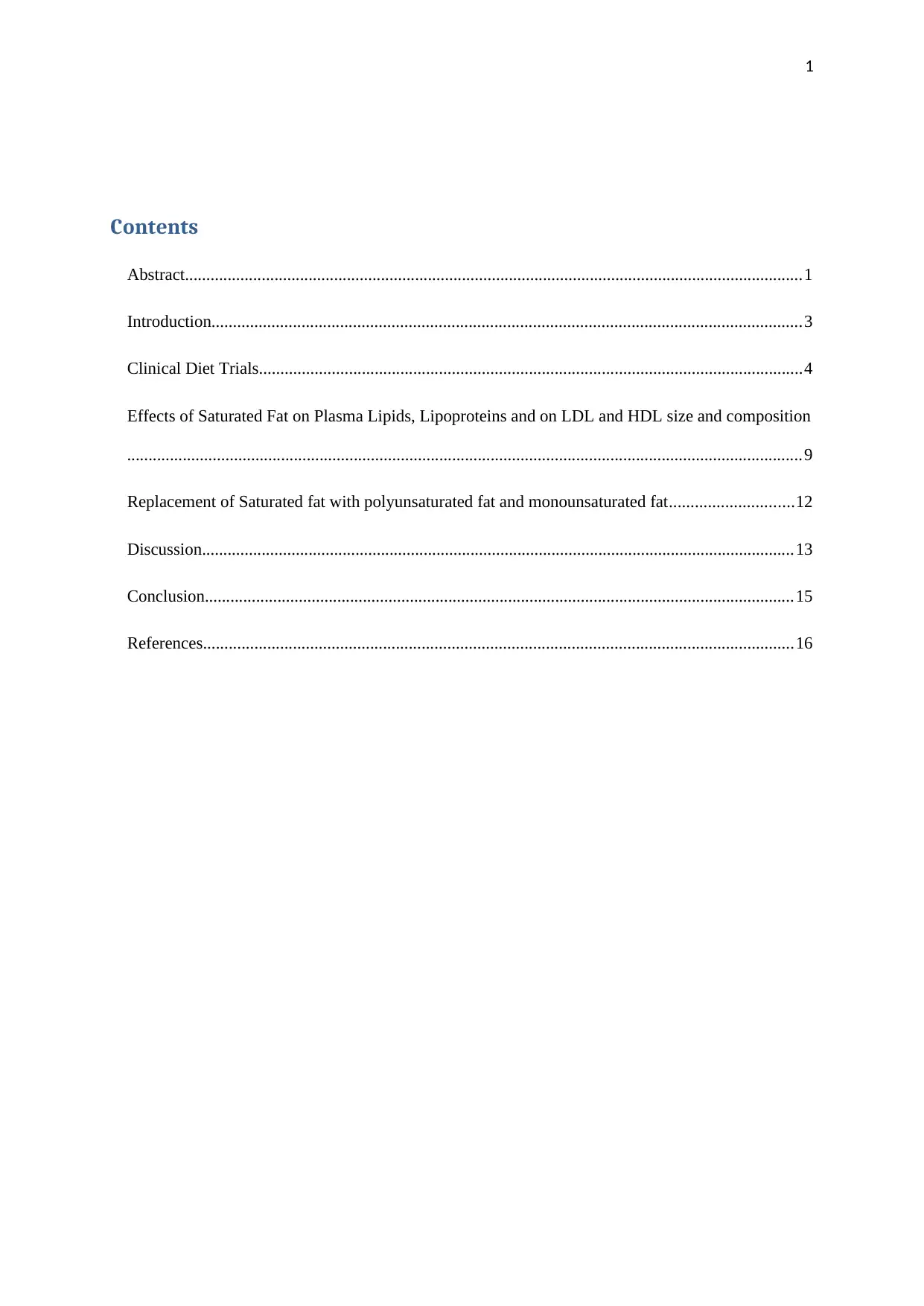
1
Contents
Abstract.................................................................................................................................................1
Introduction..........................................................................................................................................3
Clinical Diet Trials...............................................................................................................................4
Effects of Saturated Fat on Plasma Lipids, Lipoproteins and on LDL and HDL size and composition
..............................................................................................................................................................9
Replacement of Saturated fat with polyunsaturated fat and monounsaturated fat.............................12
Discussion...........................................................................................................................................13
Conclusion..........................................................................................................................................15
References..........................................................................................................................................16
Contents
Abstract.................................................................................................................................................1
Introduction..........................................................................................................................................3
Clinical Diet Trials...............................................................................................................................4
Effects of Saturated Fat on Plasma Lipids, Lipoproteins and on LDL and HDL size and composition
..............................................................................................................................................................9
Replacement of Saturated fat with polyunsaturated fat and monounsaturated fat.............................12
Discussion...........................................................................................................................................13
Conclusion..........................................................................................................................................15
References..........................................................................................................................................16
Paraphrase This Document
Need a fresh take? Get an instant paraphrase of this document with our AI Paraphraser
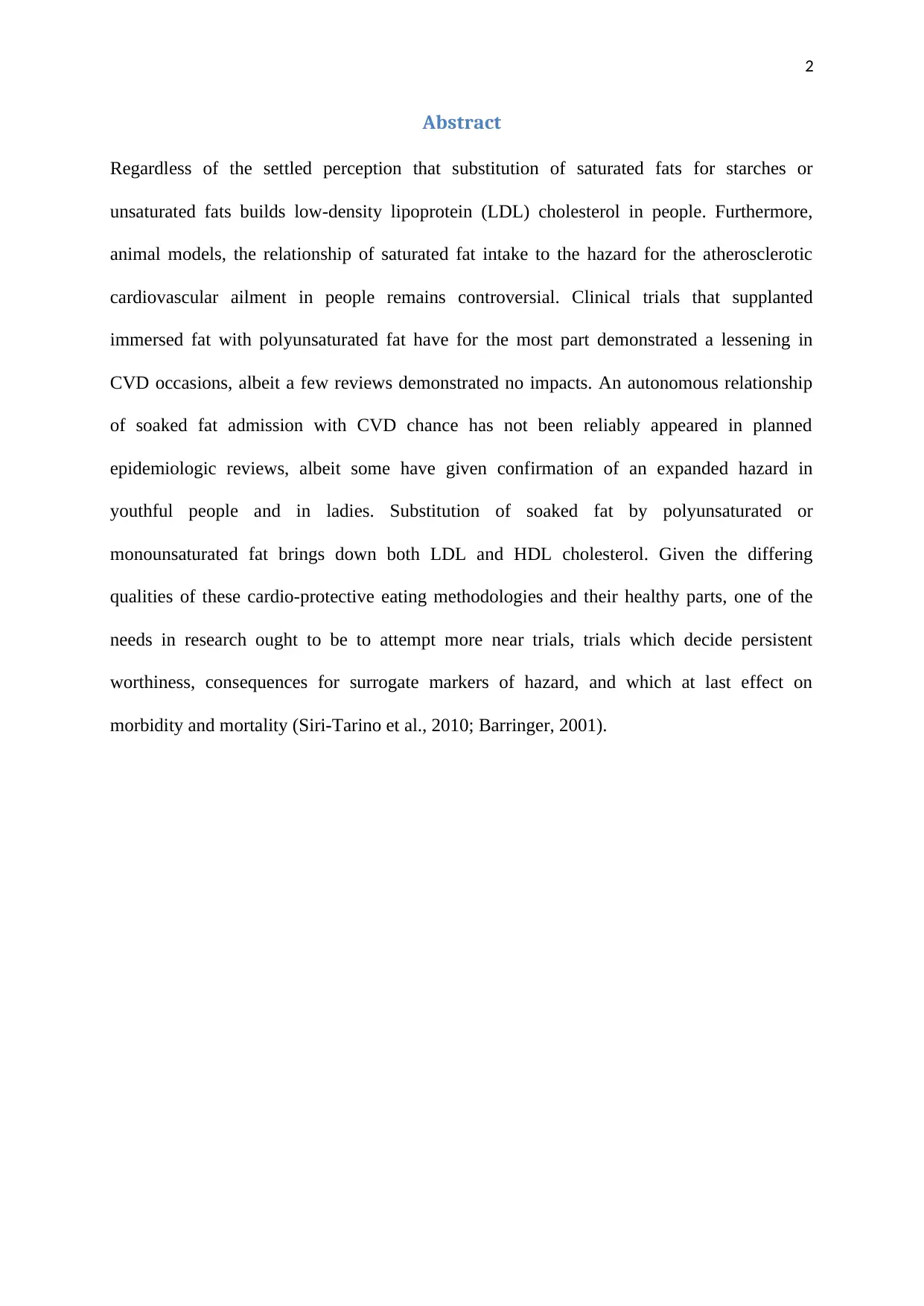
2
Abstract
Regardless of the settled perception that substitution of saturated fats for starches or
unsaturated fats builds low-density lipoprotein (LDL) cholesterol in people. Furthermore,
animal models, the relationship of saturated fat intake to the hazard for the atherosclerotic
cardiovascular ailment in people remains controversial. Clinical trials that supplanted
immersed fat with polyunsaturated fat have for the most part demonstrated a lessening in
CVD occasions, albeit a few reviews demonstrated no impacts. An autonomous relationship
of soaked fat admission with CVD chance has not been reliably appeared in planned
epidemiologic reviews, albeit some have given confirmation of an expanded hazard in
youthful people and in ladies. Substitution of soaked fat by polyunsaturated or
monounsaturated fat brings down both LDL and HDL cholesterol. Given the differing
qualities of these cardio-protective eating methodologies and their healthy parts, one of the
needs in research ought to be to attempt more near trials, trials which decide persistent
worthiness, consequences for surrogate markers of hazard, and which at last effect on
morbidity and mortality (Siri-Tarino et al., 2010; Barringer, 2001).
Abstract
Regardless of the settled perception that substitution of saturated fats for starches or
unsaturated fats builds low-density lipoprotein (LDL) cholesterol in people. Furthermore,
animal models, the relationship of saturated fat intake to the hazard for the atherosclerotic
cardiovascular ailment in people remains controversial. Clinical trials that supplanted
immersed fat with polyunsaturated fat have for the most part demonstrated a lessening in
CVD occasions, albeit a few reviews demonstrated no impacts. An autonomous relationship
of soaked fat admission with CVD chance has not been reliably appeared in planned
epidemiologic reviews, albeit some have given confirmation of an expanded hazard in
youthful people and in ladies. Substitution of soaked fat by polyunsaturated or
monounsaturated fat brings down both LDL and HDL cholesterol. Given the differing
qualities of these cardio-protective eating methodologies and their healthy parts, one of the
needs in research ought to be to attempt more near trials, trials which decide persistent
worthiness, consequences for surrogate markers of hazard, and which at last effect on
morbidity and mortality (Siri-Tarino et al., 2010; Barringer, 2001).
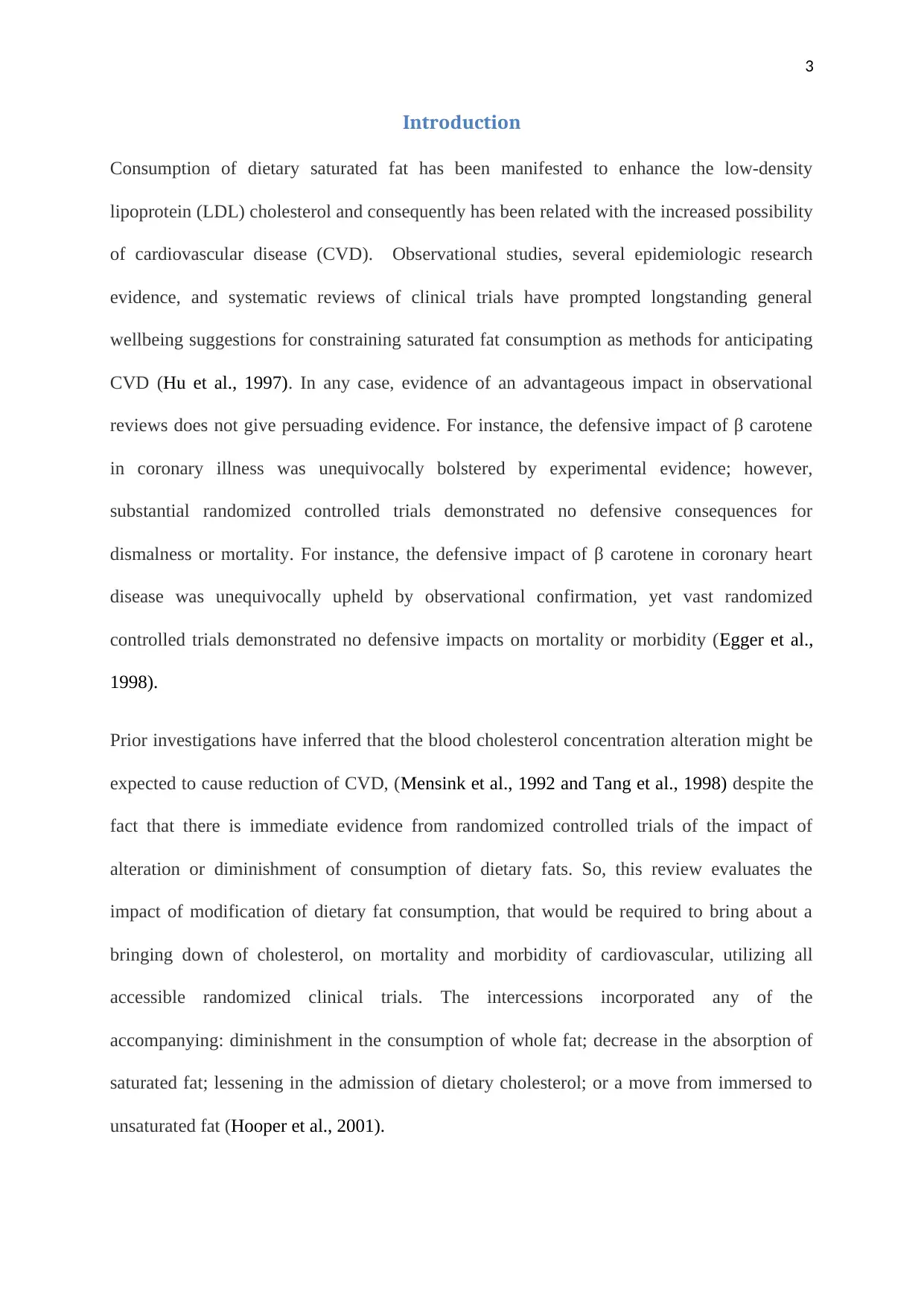
3
Introduction
Consumption of dietary saturated fat has been manifested to enhance the low-density
lipoprotein (LDL) cholesterol and consequently has been related with the increased possibility
of cardiovascular disease (CVD). Observational studies, several epidemiologic research
evidence, and systematic reviews of clinical trials have prompted longstanding general
wellbeing suggestions for constraining saturated fat consumption as methods for anticipating
CVD (Hu et al., 1997). In any case, evidence of an advantageous impact in observational
reviews does not give persuading evidence. For instance, the defensive impact of β carotene
in coronary illness was unequivocally bolstered by experimental evidence; however,
substantial randomized controlled trials demonstrated no defensive consequences for
dismalness or mortality. For instance, the defensive impact of β carotene in coronary heart
disease was unequivocally upheld by observational confirmation, yet vast randomized
controlled trials demonstrated no defensive impacts on mortality or morbidity (Egger et al.,
1998).
Prior investigations have inferred that the blood cholesterol concentration alteration might be
expected to cause reduction of CVD, (Mensink et al., 1992 and Tang et al., 1998) despite the
fact that there is immediate evidence from randomized controlled trials of the impact of
alteration or diminishment of consumption of dietary fats. So, this review evaluates the
impact of modification of dietary fat consumption, that would be required to bring about a
bringing down of cholesterol, on mortality and morbidity of cardiovascular, utilizing all
accessible randomized clinical trials. The intercessions incorporated any of the
accompanying: diminishment in the consumption of whole fat; decrease in the absorption of
saturated fat; lessening in the admission of dietary cholesterol; or a move from immersed to
unsaturated fat (Hooper et al., 2001).
Introduction
Consumption of dietary saturated fat has been manifested to enhance the low-density
lipoprotein (LDL) cholesterol and consequently has been related with the increased possibility
of cardiovascular disease (CVD). Observational studies, several epidemiologic research
evidence, and systematic reviews of clinical trials have prompted longstanding general
wellbeing suggestions for constraining saturated fat consumption as methods for anticipating
CVD (Hu et al., 1997). In any case, evidence of an advantageous impact in observational
reviews does not give persuading evidence. For instance, the defensive impact of β carotene
in coronary illness was unequivocally bolstered by experimental evidence; however,
substantial randomized controlled trials demonstrated no defensive consequences for
dismalness or mortality. For instance, the defensive impact of β carotene in coronary heart
disease was unequivocally upheld by observational confirmation, yet vast randomized
controlled trials demonstrated no defensive impacts on mortality or morbidity (Egger et al.,
1998).
Prior investigations have inferred that the blood cholesterol concentration alteration might be
expected to cause reduction of CVD, (Mensink et al., 1992 and Tang et al., 1998) despite the
fact that there is immediate evidence from randomized controlled trials of the impact of
alteration or diminishment of consumption of dietary fats. So, this review evaluates the
impact of modification of dietary fat consumption, that would be required to bring about a
bringing down of cholesterol, on mortality and morbidity of cardiovascular, utilizing all
accessible randomized clinical trials. The intercessions incorporated any of the
accompanying: diminishment in the consumption of whole fat; decrease in the absorption of
saturated fat; lessening in the admission of dietary cholesterol; or a move from immersed to
unsaturated fat (Hooper et al., 2001).
⊘ This is a preview!⊘
Do you want full access?
Subscribe today to unlock all pages.

Trusted by 1+ million students worldwide
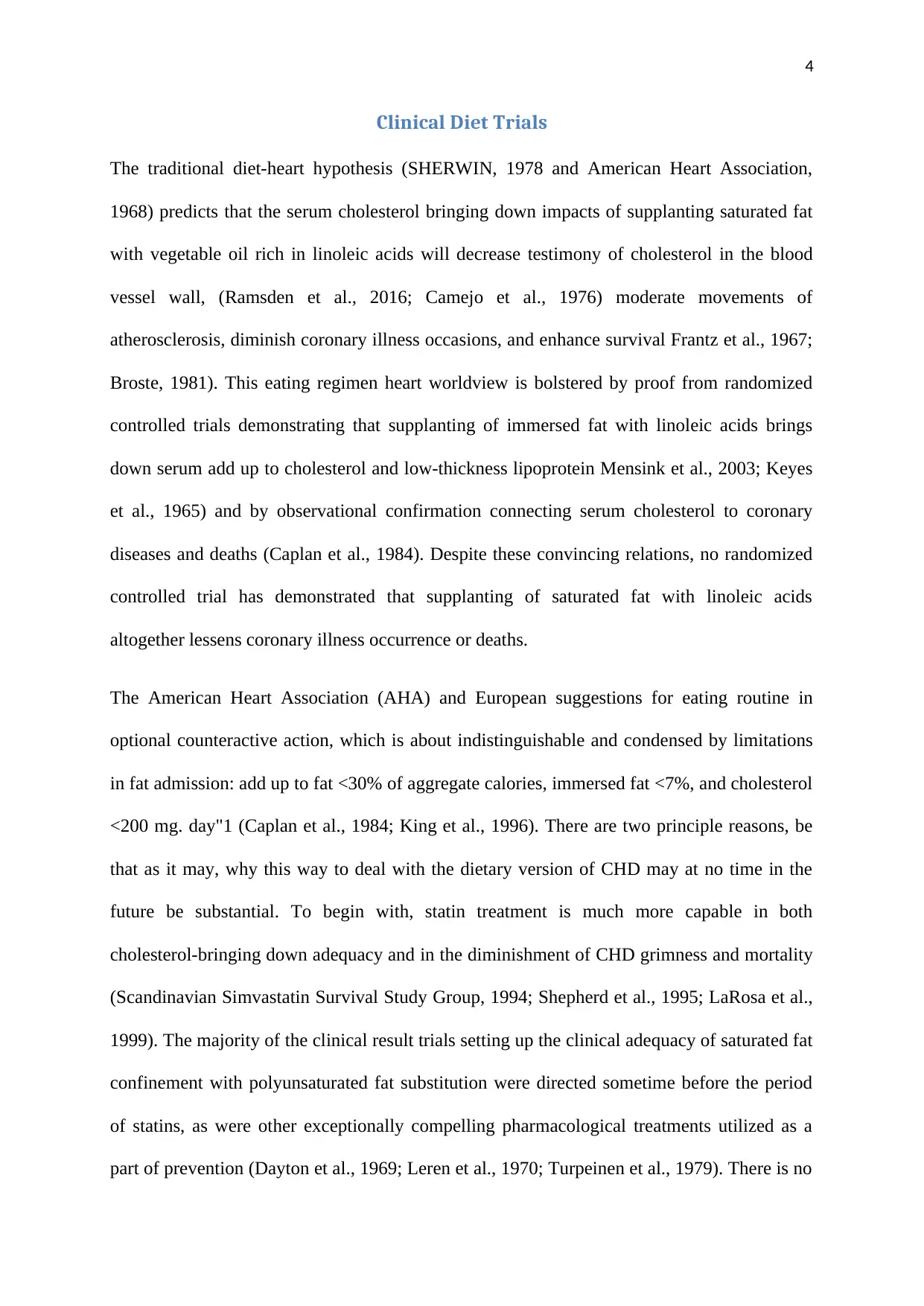
4
Clinical Diet Trials
The traditional diet-heart hypothesis (SHERWIN, 1978 and American Heart Association,
1968) predicts that the serum cholesterol bringing down impacts of supplanting saturated fat
with vegetable oil rich in linoleic acids will decrease testimony of cholesterol in the blood
vessel wall, (Ramsden et al., 2016; Camejo et al., 1976) moderate movements of
atherosclerosis, diminish coronary illness occasions, and enhance survival Frantz et al., 1967;
Broste, 1981). This eating regimen heart worldview is bolstered by proof from randomized
controlled trials demonstrating that supplanting of immersed fat with linoleic acids brings
down serum add up to cholesterol and low-thickness lipoprotein Mensink et al., 2003; Keyes
et al., 1965) and by observational confirmation connecting serum cholesterol to coronary
diseases and deaths (Caplan et al., 1984). Despite these convincing relations, no randomized
controlled trial has demonstrated that supplanting of saturated fat with linoleic acids
altogether lessens coronary illness occurrence or deaths.
The American Heart Association (AHA) and European suggestions for eating routine in
optional counteractive action, which is about indistinguishable and condensed by limitations
in fat admission: add up to fat <30% of aggregate calories, immersed fat <7%, and cholesterol
<200 mg. day"1 (Caplan et al., 1984; King et al., 1996). There are two principle reasons, be
that as it may, why this way to deal with the dietary version of CHD may at no time in the
future be substantial. To begin with, statin treatment is much more capable in both
cholesterol-bringing down adequacy and in the diminishment of CHD grimness and mortality
(Scandinavian Simvastatin Survival Study Group, 1994; Shepherd et al., 1995; LaRosa et al.,
1999). The majority of the clinical result trials setting up the clinical adequacy of saturated fat
confinement with polyunsaturated fat substitution were directed sometime before the period
of statins, as were other exceptionally compelling pharmacological treatments utilized as a
part of prevention (Dayton et al., 1969; Leren et al., 1970; Turpeinen et al., 1979). There is no
Clinical Diet Trials
The traditional diet-heart hypothesis (SHERWIN, 1978 and American Heart Association,
1968) predicts that the serum cholesterol bringing down impacts of supplanting saturated fat
with vegetable oil rich in linoleic acids will decrease testimony of cholesterol in the blood
vessel wall, (Ramsden et al., 2016; Camejo et al., 1976) moderate movements of
atherosclerosis, diminish coronary illness occasions, and enhance survival Frantz et al., 1967;
Broste, 1981). This eating regimen heart worldview is bolstered by proof from randomized
controlled trials demonstrating that supplanting of immersed fat with linoleic acids brings
down serum add up to cholesterol and low-thickness lipoprotein Mensink et al., 2003; Keyes
et al., 1965) and by observational confirmation connecting serum cholesterol to coronary
diseases and deaths (Caplan et al., 1984). Despite these convincing relations, no randomized
controlled trial has demonstrated that supplanting of saturated fat with linoleic acids
altogether lessens coronary illness occurrence or deaths.
The American Heart Association (AHA) and European suggestions for eating routine in
optional counteractive action, which is about indistinguishable and condensed by limitations
in fat admission: add up to fat <30% of aggregate calories, immersed fat <7%, and cholesterol
<200 mg. day"1 (Caplan et al., 1984; King et al., 1996). There are two principle reasons, be
that as it may, why this way to deal with the dietary version of CHD may at no time in the
future be substantial. To begin with, statin treatment is much more capable in both
cholesterol-bringing down adequacy and in the diminishment of CHD grimness and mortality
(Scandinavian Simvastatin Survival Study Group, 1994; Shepherd et al., 1995; LaRosa et al.,
1999). The majority of the clinical result trials setting up the clinical adequacy of saturated fat
confinement with polyunsaturated fat substitution were directed sometime before the period
of statins, as were other exceptionally compelling pharmacological treatments utilized as a
part of prevention (Dayton et al., 1969; Leren et al., 1970; Turpeinen et al., 1979). There is no
Paraphrase This Document
Need a fresh take? Get an instant paraphrase of this document with our AI Paraphraser
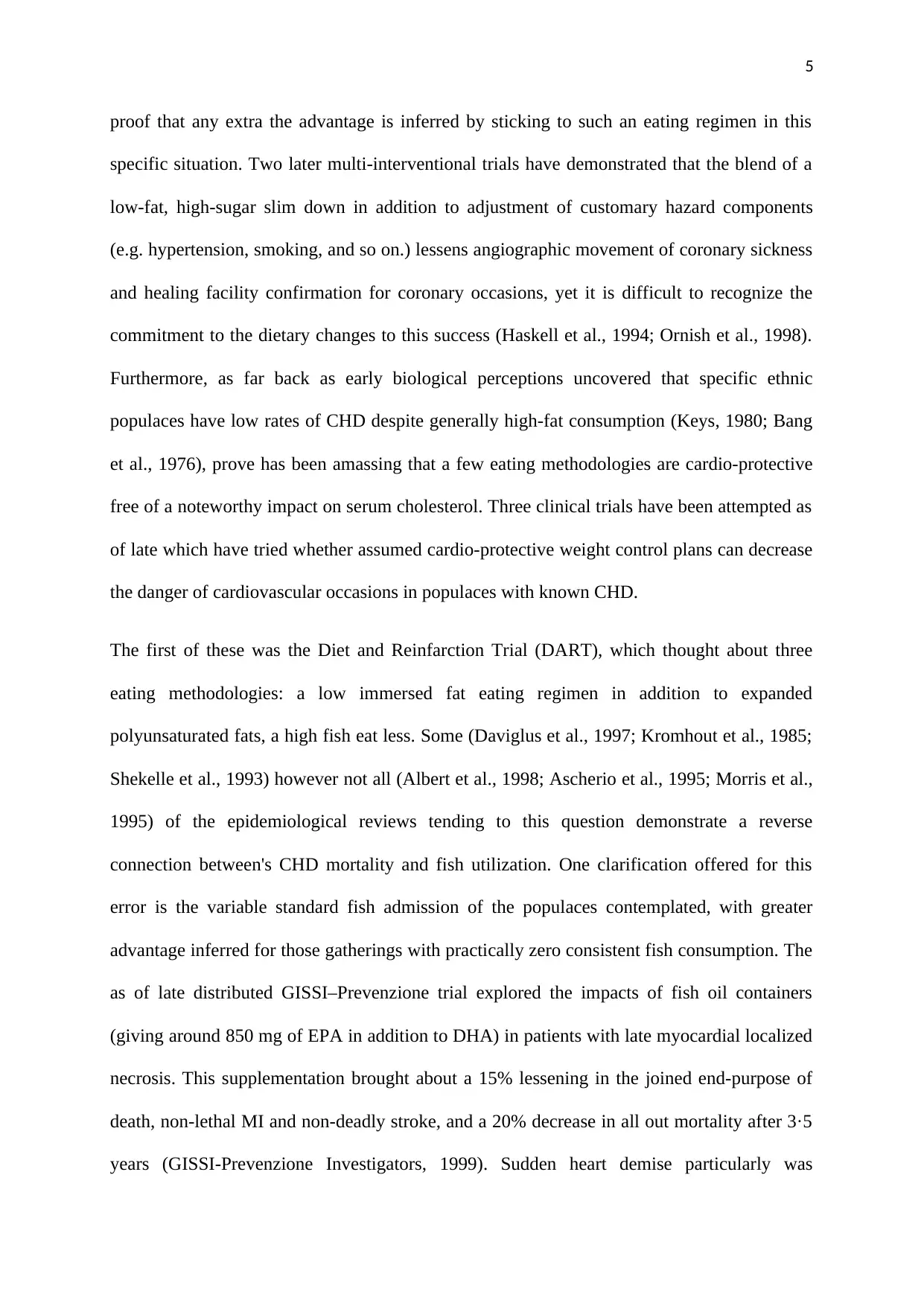
5
proof that any extra the advantage is inferred by sticking to such an eating regimen in this
specific situation. Two later multi-interventional trials have demonstrated that the blend of a
low-fat, high-sugar slim down in addition to adjustment of customary hazard components
(e.g. hypertension, smoking, and so on.) lessens angiographic movement of coronary sickness
and healing facility confirmation for coronary occasions, yet it is difficult to recognize the
commitment to the dietary changes to this success (Haskell et al., 1994; Ornish et al., 1998).
Furthermore, as far back as early biological perceptions uncovered that specific ethnic
populaces have low rates of CHD despite generally high-fat consumption (Keys, 1980; Bang
et al., 1976), prove has been amassing that a few eating methodologies are cardio-protective
free of a noteworthy impact on serum cholesterol. Three clinical trials have been attempted as
of late which have tried whether assumed cardio-protective weight control plans can decrease
the danger of cardiovascular occasions in populaces with known CHD.
The first of these was the Diet and Reinfarction Trial (DART), which thought about three
eating methodologies: a low immersed fat eating regimen in addition to expanded
polyunsaturated fats, a high fish eat less. Some (Daviglus et al., 1997; Kromhout et al., 1985;
Shekelle et al., 1993) however not all (Albert et al., 1998; Ascherio et al., 1995; Morris et al.,
1995) of the epidemiological reviews tending to this question demonstrate a reverse
connection between's CHD mortality and fish utilization. One clarification offered for this
error is the variable standard fish admission of the populaces contemplated, with greater
advantage inferred for those gatherings with practically zero consistent fish consumption. The
as of late distributed GISSI–Prevenzione trial explored the impacts of fish oil containers
(giving around 850 mg of EPA in addition to DHA) in patients with late myocardial localized
necrosis. This supplementation brought about a 15% lessening in the joined end-purpose of
death, non-lethal MI and non-deadly stroke, and a 20% decrease in all out mortality after 3·5
years (GISSI-Prevenzione Investigators, 1999). Sudden heart demise particularly was
proof that any extra the advantage is inferred by sticking to such an eating regimen in this
specific situation. Two later multi-interventional trials have demonstrated that the blend of a
low-fat, high-sugar slim down in addition to adjustment of customary hazard components
(e.g. hypertension, smoking, and so on.) lessens angiographic movement of coronary sickness
and healing facility confirmation for coronary occasions, yet it is difficult to recognize the
commitment to the dietary changes to this success (Haskell et al., 1994; Ornish et al., 1998).
Furthermore, as far back as early biological perceptions uncovered that specific ethnic
populaces have low rates of CHD despite generally high-fat consumption (Keys, 1980; Bang
et al., 1976), prove has been amassing that a few eating methodologies are cardio-protective
free of a noteworthy impact on serum cholesterol. Three clinical trials have been attempted as
of late which have tried whether assumed cardio-protective weight control plans can decrease
the danger of cardiovascular occasions in populaces with known CHD.
The first of these was the Diet and Reinfarction Trial (DART), which thought about three
eating methodologies: a low immersed fat eating regimen in addition to expanded
polyunsaturated fats, a high fish eat less. Some (Daviglus et al., 1997; Kromhout et al., 1985;
Shekelle et al., 1993) however not all (Albert et al., 1998; Ascherio et al., 1995; Morris et al.,
1995) of the epidemiological reviews tending to this question demonstrate a reverse
connection between's CHD mortality and fish utilization. One clarification offered for this
error is the variable standard fish admission of the populaces contemplated, with greater
advantage inferred for those gatherings with practically zero consistent fish consumption. The
as of late distributed GISSI–Prevenzione trial explored the impacts of fish oil containers
(giving around 850 mg of EPA in addition to DHA) in patients with late myocardial localized
necrosis. This supplementation brought about a 15% lessening in the joined end-purpose of
death, non-lethal MI and non-deadly stroke, and a 20% decrease in all out mortality after 3·5
years (GISSI-Prevenzione Investigators, 1999). Sudden heart demise particularly was
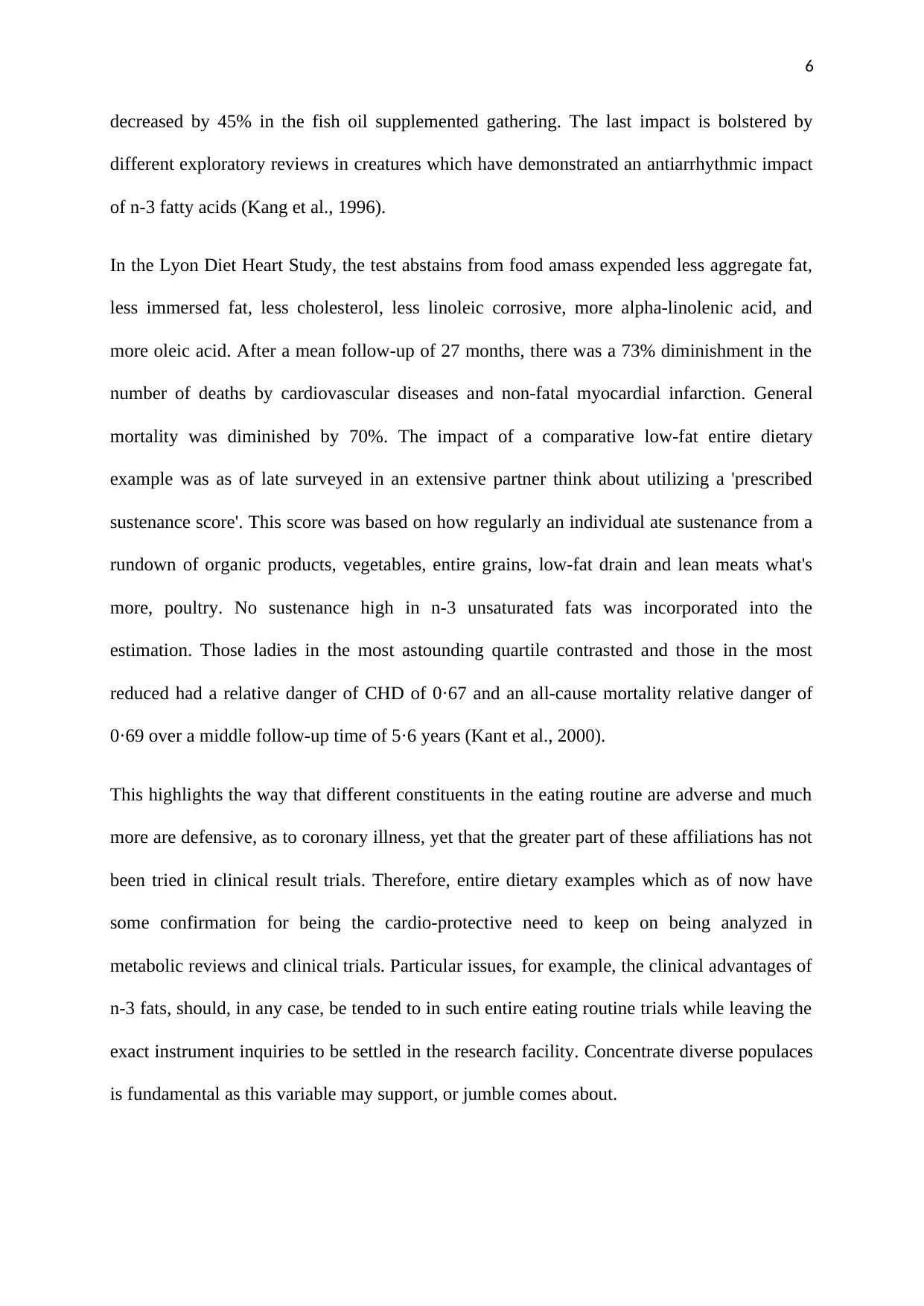
6
decreased by 45% in the fish oil supplemented gathering. The last impact is bolstered by
different exploratory reviews in creatures which have demonstrated an antiarrhythmic impact
of n-3 fatty acids (Kang et al., 1996).
In the Lyon Diet Heart Study, the test abstains from food amass expended less aggregate fat,
less immersed fat, less cholesterol, less linoleic corrosive, more alpha-linolenic acid, and
more oleic acid. After a mean follow-up of 27 months, there was a 73% diminishment in the
number of deaths by cardiovascular diseases and non-fatal myocardial infarction. General
mortality was diminished by 70%. The impact of a comparative low-fat entire dietary
example was as of late surveyed in an extensive partner think about utilizing a 'prescribed
sustenance score'. This score was based on how regularly an individual ate sustenance from a
rundown of organic products, vegetables, entire grains, low-fat drain and lean meats what's
more, poultry. No sustenance high in n-3 unsaturated fats was incorporated into the
estimation. Those ladies in the most astounding quartile contrasted and those in the most
reduced had a relative danger of CHD of 0·67 and an all-cause mortality relative danger of
0·69 over a middle follow-up time of 5·6 years (Kant et al., 2000).
This highlights the way that different constituents in the eating routine are adverse and much
more are defensive, as to coronary illness, yet that the greater part of these affiliations has not
been tried in clinical result trials. Therefore, entire dietary examples which as of now have
some confirmation for being the cardio-protective need to keep on being analyzed in
metabolic reviews and clinical trials. Particular issues, for example, the clinical advantages of
n-3 fats, should, in any case, be tended to in such entire eating routine trials while leaving the
exact instrument inquiries to be settled in the research facility. Concentrate diverse populaces
is fundamental as this variable may support, or jumble comes about.
decreased by 45% in the fish oil supplemented gathering. The last impact is bolstered by
different exploratory reviews in creatures which have demonstrated an antiarrhythmic impact
of n-3 fatty acids (Kang et al., 1996).
In the Lyon Diet Heart Study, the test abstains from food amass expended less aggregate fat,
less immersed fat, less cholesterol, less linoleic corrosive, more alpha-linolenic acid, and
more oleic acid. After a mean follow-up of 27 months, there was a 73% diminishment in the
number of deaths by cardiovascular diseases and non-fatal myocardial infarction. General
mortality was diminished by 70%. The impact of a comparative low-fat entire dietary
example was as of late surveyed in an extensive partner think about utilizing a 'prescribed
sustenance score'. This score was based on how regularly an individual ate sustenance from a
rundown of organic products, vegetables, entire grains, low-fat drain and lean meats what's
more, poultry. No sustenance high in n-3 unsaturated fats was incorporated into the
estimation. Those ladies in the most astounding quartile contrasted and those in the most
reduced had a relative danger of CHD of 0·67 and an all-cause mortality relative danger of
0·69 over a middle follow-up time of 5·6 years (Kant et al., 2000).
This highlights the way that different constituents in the eating routine are adverse and much
more are defensive, as to coronary illness, yet that the greater part of these affiliations has not
been tried in clinical result trials. Therefore, entire dietary examples which as of now have
some confirmation for being the cardio-protective need to keep on being analyzed in
metabolic reviews and clinical trials. Particular issues, for example, the clinical advantages of
n-3 fats, should, in any case, be tended to in such entire eating routine trials while leaving the
exact instrument inquiries to be settled in the research facility. Concentrate diverse populaces
is fundamental as this variable may support, or jumble comes about.
⊘ This is a preview!⊘
Do you want full access?
Subscribe today to unlock all pages.

Trusted by 1+ million students worldwide
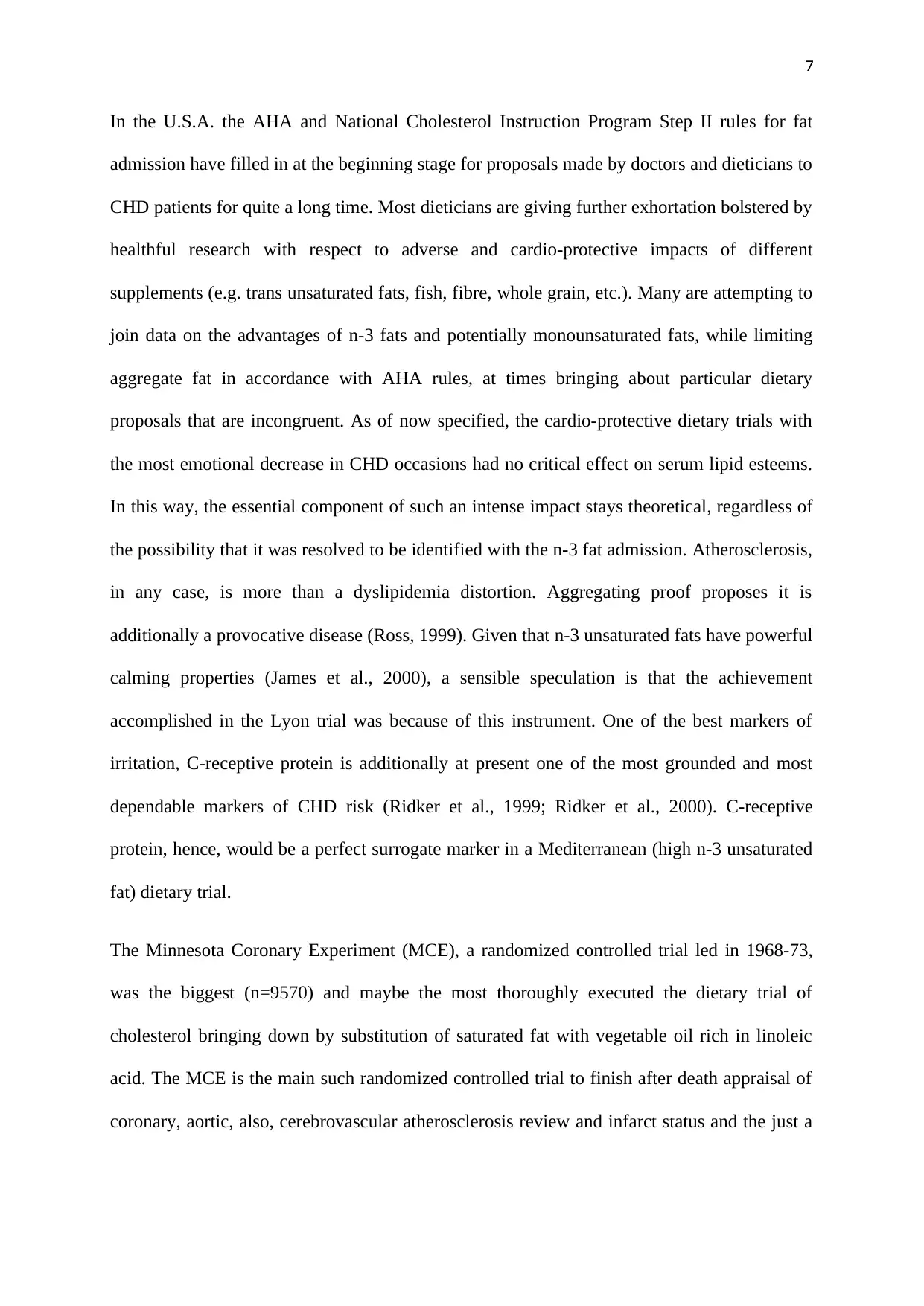
7
In the U.S.A. the AHA and National Cholesterol Instruction Program Step II rules for fat
admission have filled in at the beginning stage for proposals made by doctors and dieticians to
CHD patients for quite a long time. Most dieticians are giving further exhortation bolstered by
healthful research with respect to adverse and cardio-protective impacts of different
supplements (e.g. trans unsaturated fats, fish, fibre, whole grain, etc.). Many are attempting to
join data on the advantages of n-3 fats and potentially monounsaturated fats, while limiting
aggregate fat in accordance with AHA rules, at times bringing about particular dietary
proposals that are incongruent. As of now specified, the cardio-protective dietary trials with
the most emotional decrease in CHD occasions had no critical effect on serum lipid esteems.
In this way, the essential component of such an intense impact stays theoretical, regardless of
the possibility that it was resolved to be identified with the n-3 fat admission. Atherosclerosis,
in any case, is more than a dyslipidemia distortion. Aggregating proof proposes it is
additionally a provocative disease (Ross, 1999). Given that n-3 unsaturated fats have powerful
calming properties (James et al., 2000), a sensible speculation is that the achievement
accomplished in the Lyon trial was because of this instrument. One of the best markers of
irritation, C-receptive protein is additionally at present one of the most grounded and most
dependable markers of CHD risk (Ridker et al., 1999; Ridker et al., 2000). C-receptive
protein, hence, would be a perfect surrogate marker in a Mediterranean (high n-3 unsaturated
fat) dietary trial.
The Minnesota Coronary Experiment (MCE), a randomized controlled trial led in 1968-73,
was the biggest (n=9570) and maybe the most thoroughly executed the dietary trial of
cholesterol bringing down by substitution of saturated fat with vegetable oil rich in linoleic
acid. The MCE is the main such randomized controlled trial to finish after death appraisal of
coronary, aortic, also, cerebrovascular atherosclerosis review and infarct status and the just a
In the U.S.A. the AHA and National Cholesterol Instruction Program Step II rules for fat
admission have filled in at the beginning stage for proposals made by doctors and dieticians to
CHD patients for quite a long time. Most dieticians are giving further exhortation bolstered by
healthful research with respect to adverse and cardio-protective impacts of different
supplements (e.g. trans unsaturated fats, fish, fibre, whole grain, etc.). Many are attempting to
join data on the advantages of n-3 fats and potentially monounsaturated fats, while limiting
aggregate fat in accordance with AHA rules, at times bringing about particular dietary
proposals that are incongruent. As of now specified, the cardio-protective dietary trials with
the most emotional decrease in CHD occasions had no critical effect on serum lipid esteems.
In this way, the essential component of such an intense impact stays theoretical, regardless of
the possibility that it was resolved to be identified with the n-3 fat admission. Atherosclerosis,
in any case, is more than a dyslipidemia distortion. Aggregating proof proposes it is
additionally a provocative disease (Ross, 1999). Given that n-3 unsaturated fats have powerful
calming properties (James et al., 2000), a sensible speculation is that the achievement
accomplished in the Lyon trial was because of this instrument. One of the best markers of
irritation, C-receptive protein is additionally at present one of the most grounded and most
dependable markers of CHD risk (Ridker et al., 1999; Ridker et al., 2000). C-receptive
protein, hence, would be a perfect surrogate marker in a Mediterranean (high n-3 unsaturated
fat) dietary trial.
The Minnesota Coronary Experiment (MCE), a randomized controlled trial led in 1968-73,
was the biggest (n=9570) and maybe the most thoroughly executed the dietary trial of
cholesterol bringing down by substitution of saturated fat with vegetable oil rich in linoleic
acid. The MCE is the main such randomized controlled trial to finish after death appraisal of
coronary, aortic, also, cerebrovascular atherosclerosis review and infarct status and the just a
Paraphrase This Document
Need a fresh take? Get an instant paraphrase of this document with our AI Paraphraser
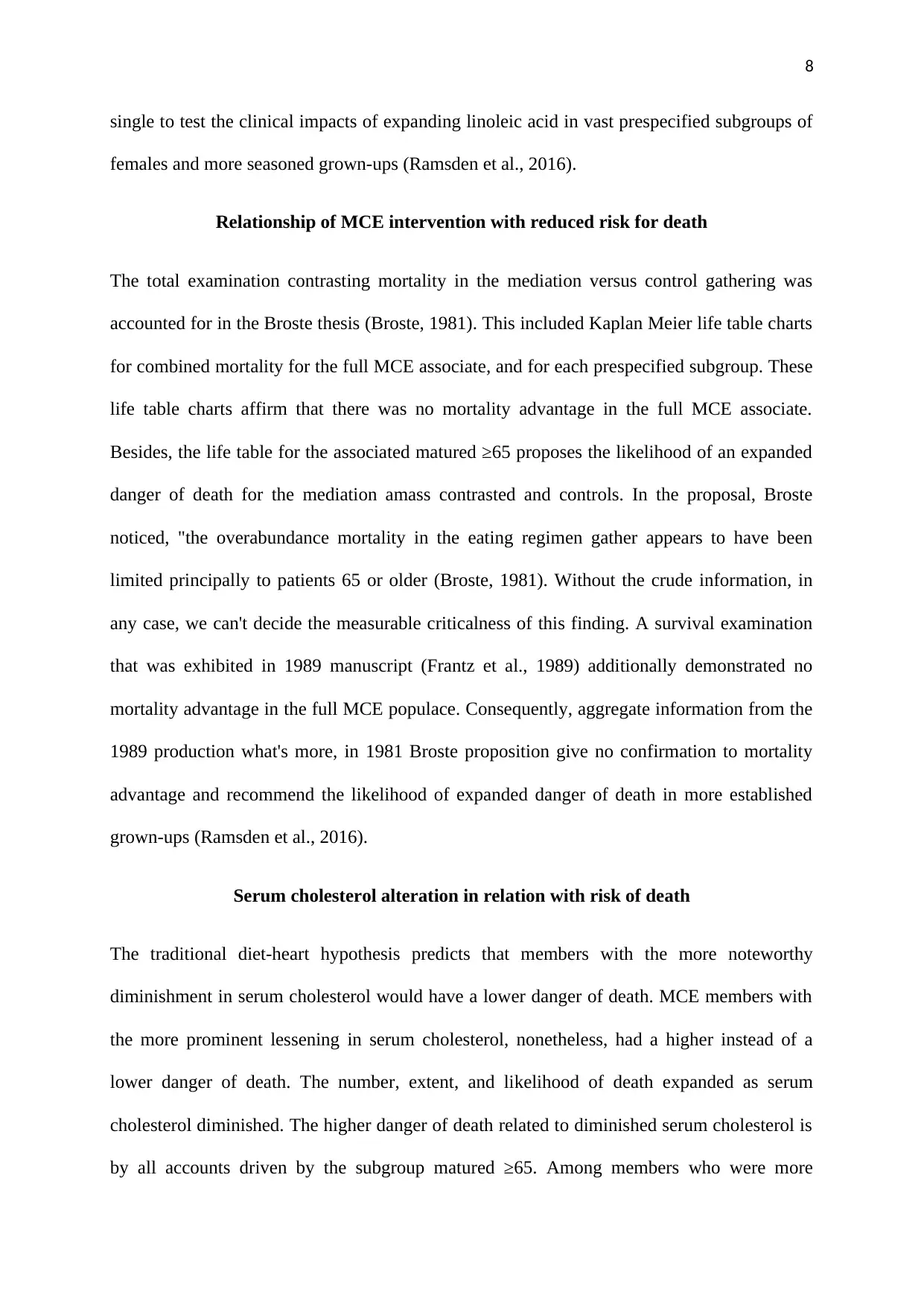
8
single to test the clinical impacts of expanding linoleic acid in vast prespecified subgroups of
females and more seasoned grown-ups (Ramsden et al., 2016).
Relationship of MCE intervention with reduced risk for death
The total examination contrasting mortality in the mediation versus control gathering was
accounted for in the Broste thesis (Broste, 1981). This included Kaplan Meier life table charts
for combined mortality for the full MCE associate, and for each prespecified subgroup. These
life table charts affirm that there was no mortality advantage in the full MCE associate.
Besides, the life table for the associated matured ≥65 proposes the likelihood of an expanded
danger of death for the mediation amass contrasted and controls. In the proposal, Broste
noticed, "the overabundance mortality in the eating regimen gather appears to have been
limited principally to patients 65 or older (Broste, 1981). Without the crude information, in
any case, we can't decide the measurable criticalness of this finding. A survival examination
that was exhibited in 1989 manuscript (Frantz et al., 1989) additionally demonstrated no
mortality advantage in the full MCE populace. Consequently, aggregate information from the
1989 production what's more, in 1981 Broste proposition give no confirmation to mortality
advantage and recommend the likelihood of expanded danger of death in more established
grown-ups (Ramsden et al., 2016).
Serum cholesterol alteration in relation with risk of death
The traditional diet-heart hypothesis predicts that members with the more noteworthy
diminishment in serum cholesterol would have a lower danger of death. MCE members with
the more prominent lessening in serum cholesterol, nonetheless, had a higher instead of a
lower danger of death. The number, extent, and likelihood of death expanded as serum
cholesterol diminished. The higher danger of death related to diminished serum cholesterol is
by all accounts driven by the subgroup matured ≥65. Among members who were more
single to test the clinical impacts of expanding linoleic acid in vast prespecified subgroups of
females and more seasoned grown-ups (Ramsden et al., 2016).
Relationship of MCE intervention with reduced risk for death
The total examination contrasting mortality in the mediation versus control gathering was
accounted for in the Broste thesis (Broste, 1981). This included Kaplan Meier life table charts
for combined mortality for the full MCE associate, and for each prespecified subgroup. These
life table charts affirm that there was no mortality advantage in the full MCE associate.
Besides, the life table for the associated matured ≥65 proposes the likelihood of an expanded
danger of death for the mediation amass contrasted and controls. In the proposal, Broste
noticed, "the overabundance mortality in the eating regimen gather appears to have been
limited principally to patients 65 or older (Broste, 1981). Without the crude information, in
any case, we can't decide the measurable criticalness of this finding. A survival examination
that was exhibited in 1989 manuscript (Frantz et al., 1989) additionally demonstrated no
mortality advantage in the full MCE populace. Consequently, aggregate information from the
1989 production what's more, in 1981 Broste proposition give no confirmation to mortality
advantage and recommend the likelihood of expanded danger of death in more established
grown-ups (Ramsden et al., 2016).
Serum cholesterol alteration in relation with risk of death
The traditional diet-heart hypothesis predicts that members with the more noteworthy
diminishment in serum cholesterol would have a lower danger of death. MCE members with
the more prominent lessening in serum cholesterol, nonetheless, had a higher instead of a
lower danger of death. The number, extent, and likelihood of death expanded as serum
cholesterol diminished. The higher danger of death related to diminished serum cholesterol is
by all accounts driven by the subgroup matured ≥65. Among members who were more
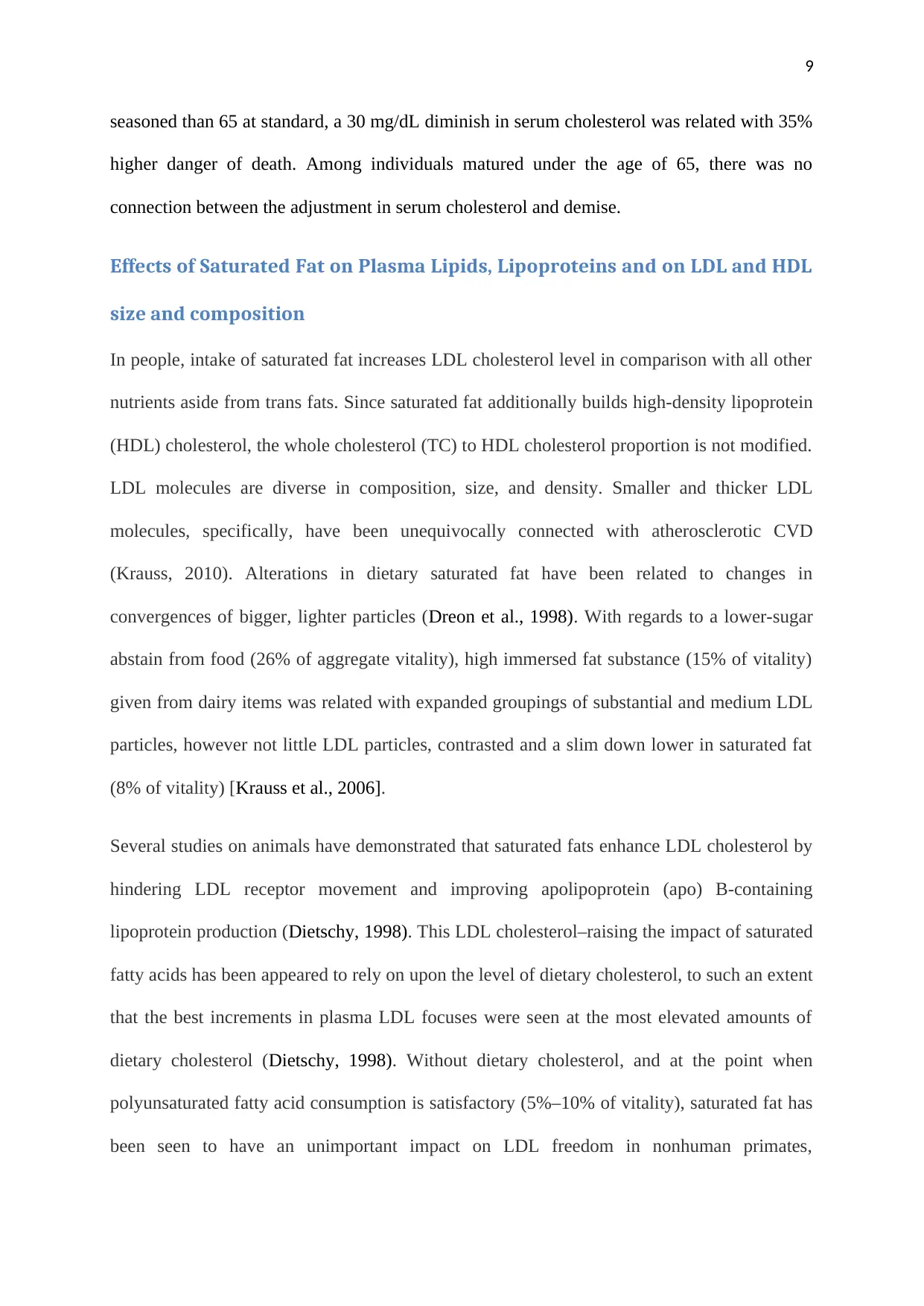
9
seasoned than 65 at standard, a 30 mg/dL diminish in serum cholesterol was related with 35%
higher danger of death. Among individuals matured under the age of 65, there was no
connection between the adjustment in serum cholesterol and demise.
Effects of Saturated Fat on Plasma Lipids, Lipoproteins and on LDL and HDL
size and composition
In people, intake of saturated fat increases LDL cholesterol level in comparison with all other
nutrients aside from trans fats. Since saturated fat additionally builds high-density lipoprotein
(HDL) cholesterol, the whole cholesterol (TC) to HDL cholesterol proportion is not modified.
LDL molecules are diverse in composition, size, and density. Smaller and thicker LDL
molecules, specifically, have been unequivocally connected with atherosclerotic CVD
(Krauss, 2010). Alterations in dietary saturated fat have been related to changes in
convergences of bigger, lighter particles (Dreon et al., 1998). With regards to a lower-sugar
abstain from food (26% of aggregate vitality), high immersed fat substance (15% of vitality)
given from dairy items was related with expanded groupings of substantial and medium LDL
particles, however not little LDL particles, contrasted and a slim down lower in saturated fat
(8% of vitality) [Krauss et al., 2006].
Several studies on animals have demonstrated that saturated fats enhance LDL cholesterol by
hindering LDL receptor movement and improving apolipoprotein (apo) B-containing
lipoprotein production (Dietschy, 1998). This LDL cholesterol–raising the impact of saturated
fatty acids has been appeared to rely on upon the level of dietary cholesterol, to such an extent
that the best increments in plasma LDL focuses were seen at the most elevated amounts of
dietary cholesterol (Dietschy, 1998). Without dietary cholesterol, and at the point when
polyunsaturated fatty acid consumption is satisfactory (5%–10% of vitality), saturated fat has
been seen to have an unimportant impact on LDL freedom in nonhuman primates,
seasoned than 65 at standard, a 30 mg/dL diminish in serum cholesterol was related with 35%
higher danger of death. Among individuals matured under the age of 65, there was no
connection between the adjustment in serum cholesterol and demise.
Effects of Saturated Fat on Plasma Lipids, Lipoproteins and on LDL and HDL
size and composition
In people, intake of saturated fat increases LDL cholesterol level in comparison with all other
nutrients aside from trans fats. Since saturated fat additionally builds high-density lipoprotein
(HDL) cholesterol, the whole cholesterol (TC) to HDL cholesterol proportion is not modified.
LDL molecules are diverse in composition, size, and density. Smaller and thicker LDL
molecules, specifically, have been unequivocally connected with atherosclerotic CVD
(Krauss, 2010). Alterations in dietary saturated fat have been related to changes in
convergences of bigger, lighter particles (Dreon et al., 1998). With regards to a lower-sugar
abstain from food (26% of aggregate vitality), high immersed fat substance (15% of vitality)
given from dairy items was related with expanded groupings of substantial and medium LDL
particles, however not little LDL particles, contrasted and a slim down lower in saturated fat
(8% of vitality) [Krauss et al., 2006].
Several studies on animals have demonstrated that saturated fats enhance LDL cholesterol by
hindering LDL receptor movement and improving apolipoprotein (apo) B-containing
lipoprotein production (Dietschy, 1998). This LDL cholesterol–raising the impact of saturated
fatty acids has been appeared to rely on upon the level of dietary cholesterol, to such an extent
that the best increments in plasma LDL focuses were seen at the most elevated amounts of
dietary cholesterol (Dietschy, 1998). Without dietary cholesterol, and at the point when
polyunsaturated fatty acid consumption is satisfactory (5%–10% of vitality), saturated fat has
been seen to have an unimportant impact on LDL freedom in nonhuman primates,
⊘ This is a preview!⊘
Do you want full access?
Subscribe today to unlock all pages.

Trusted by 1+ million students worldwide
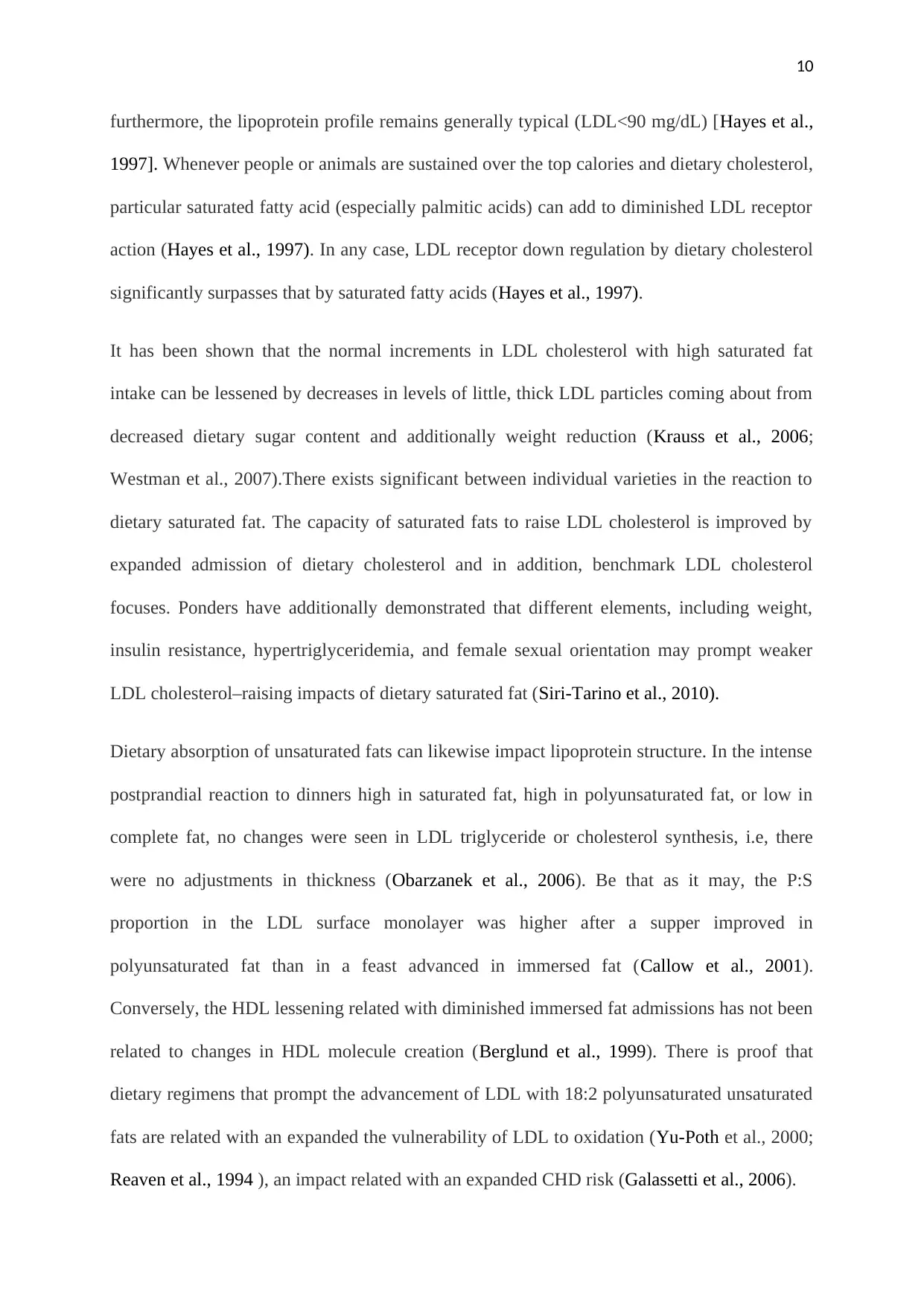
10
furthermore, the lipoprotein profile remains generally typical (LDL<90 mg/dL) [Hayes et al.,
1997]. Whenever people or animals are sustained over the top calories and dietary cholesterol,
particular saturated fatty acid (especially palmitic acids) can add to diminished LDL receptor
action (Hayes et al., 1997). In any case, LDL receptor down regulation by dietary cholesterol
significantly surpasses that by saturated fatty acids (Hayes et al., 1997).
It has been shown that the normal increments in LDL cholesterol with high saturated fat
intake can be lessened by decreases in levels of little, thick LDL particles coming about from
decreased dietary sugar content and additionally weight reduction (Krauss et al., 2006;
Westman et al., 2007).There exists significant between individual varieties in the reaction to
dietary saturated fat. The capacity of saturated fats to raise LDL cholesterol is improved by
expanded admission of dietary cholesterol and in addition, benchmark LDL cholesterol
focuses. Ponders have additionally demonstrated that different elements, including weight,
insulin resistance, hypertriglyceridemia, and female sexual orientation may prompt weaker
LDL cholesterol–raising impacts of dietary saturated fat (Siri-Tarino et al., 2010).
Dietary absorption of unsaturated fats can likewise impact lipoprotein structure. In the intense
postprandial reaction to dinners high in saturated fat, high in polyunsaturated fat, or low in
complete fat, no changes were seen in LDL triglyceride or cholesterol synthesis, i.e, there
were no adjustments in thickness (Obarzanek et al., 2006). Be that as it may, the P:S
proportion in the LDL surface monolayer was higher after a supper improved in
polyunsaturated fat than in a feast advanced in immersed fat (Callow et al., 2001).
Conversely, the HDL lessening related with diminished immersed fat admissions has not been
related to changes in HDL molecule creation (Berglund et al., 1999). There is proof that
dietary regimens that prompt the advancement of LDL with 18:2 polyunsaturated unsaturated
fats are related with an expanded the vulnerability of LDL to oxidation (Yu-Poth et al., 2000;
Reaven et al., 1994 ), an impact related with an expanded CHD risk (Galassetti et al., 2006).
furthermore, the lipoprotein profile remains generally typical (LDL<90 mg/dL) [Hayes et al.,
1997]. Whenever people or animals are sustained over the top calories and dietary cholesterol,
particular saturated fatty acid (especially palmitic acids) can add to diminished LDL receptor
action (Hayes et al., 1997). In any case, LDL receptor down regulation by dietary cholesterol
significantly surpasses that by saturated fatty acids (Hayes et al., 1997).
It has been shown that the normal increments in LDL cholesterol with high saturated fat
intake can be lessened by decreases in levels of little, thick LDL particles coming about from
decreased dietary sugar content and additionally weight reduction (Krauss et al., 2006;
Westman et al., 2007).There exists significant between individual varieties in the reaction to
dietary saturated fat. The capacity of saturated fats to raise LDL cholesterol is improved by
expanded admission of dietary cholesterol and in addition, benchmark LDL cholesterol
focuses. Ponders have additionally demonstrated that different elements, including weight,
insulin resistance, hypertriglyceridemia, and female sexual orientation may prompt weaker
LDL cholesterol–raising impacts of dietary saturated fat (Siri-Tarino et al., 2010).
Dietary absorption of unsaturated fats can likewise impact lipoprotein structure. In the intense
postprandial reaction to dinners high in saturated fat, high in polyunsaturated fat, or low in
complete fat, no changes were seen in LDL triglyceride or cholesterol synthesis, i.e, there
were no adjustments in thickness (Obarzanek et al., 2006). Be that as it may, the P:S
proportion in the LDL surface monolayer was higher after a supper improved in
polyunsaturated fat than in a feast advanced in immersed fat (Callow et al., 2001).
Conversely, the HDL lessening related with diminished immersed fat admissions has not been
related to changes in HDL molecule creation (Berglund et al., 1999). There is proof that
dietary regimens that prompt the advancement of LDL with 18:2 polyunsaturated unsaturated
fats are related with an expanded the vulnerability of LDL to oxidation (Yu-Poth et al., 2000;
Reaven et al., 1994 ), an impact related with an expanded CHD risk (Galassetti et al., 2006).
Paraphrase This Document
Need a fresh take? Get an instant paraphrase of this document with our AI Paraphraser
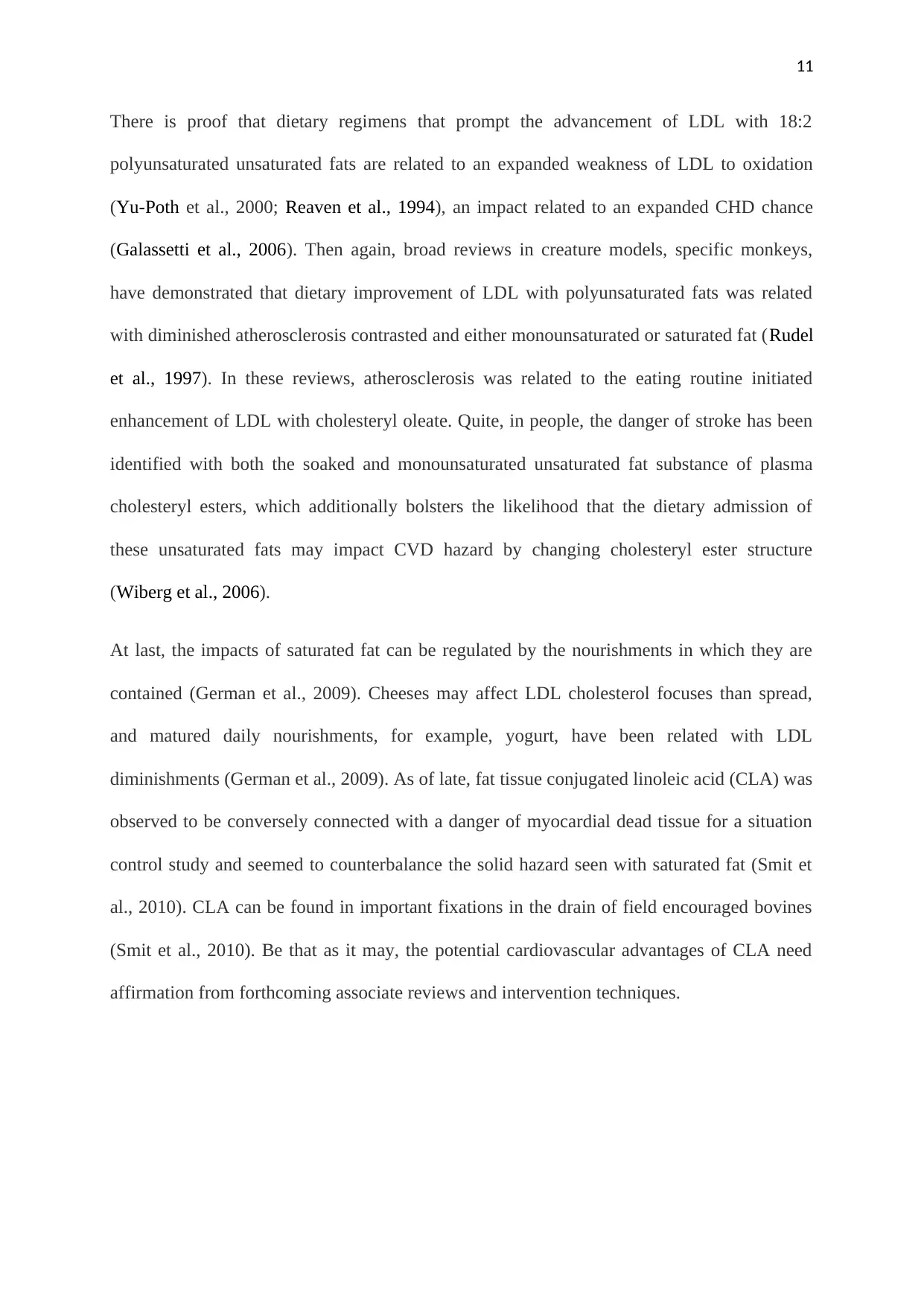
11
There is proof that dietary regimens that prompt the advancement of LDL with 18:2
polyunsaturated unsaturated fats are related to an expanded weakness of LDL to oxidation
(Yu-Poth et al., 2000; Reaven et al., 1994), an impact related to an expanded CHD chance
(Galassetti et al., 2006). Then again, broad reviews in creature models, specific monkeys,
have demonstrated that dietary improvement of LDL with polyunsaturated fats was related
with diminished atherosclerosis contrasted and either monounsaturated or saturated fat (Rudel
et al., 1997). In these reviews, atherosclerosis was related to the eating routine initiated
enhancement of LDL with cholesteryl oleate. Quite, in people, the danger of stroke has been
identified with both the soaked and monounsaturated unsaturated fat substance of plasma
cholesteryl esters, which additionally bolsters the likelihood that the dietary admission of
these unsaturated fats may impact CVD hazard by changing cholesteryl ester structure
(Wiberg et al., 2006).
At last, the impacts of saturated fat can be regulated by the nourishments in which they are
contained (German et al., 2009). Cheeses may affect LDL cholesterol focuses than spread,
and matured daily nourishments, for example, yogurt, have been related with LDL
diminishments (German et al., 2009). As of late, fat tissue conjugated linoleic acid (CLA) was
observed to be conversely connected with a danger of myocardial dead tissue for a situation
control study and seemed to counterbalance the solid hazard seen with saturated fat (Smit et
al., 2010). CLA can be found in important fixations in the drain of field encouraged bovines
(Smit et al., 2010). Be that as it may, the potential cardiovascular advantages of CLA need
affirmation from forthcoming associate reviews and intervention techniques.
There is proof that dietary regimens that prompt the advancement of LDL with 18:2
polyunsaturated unsaturated fats are related to an expanded weakness of LDL to oxidation
(Yu-Poth et al., 2000; Reaven et al., 1994), an impact related to an expanded CHD chance
(Galassetti et al., 2006). Then again, broad reviews in creature models, specific monkeys,
have demonstrated that dietary improvement of LDL with polyunsaturated fats was related
with diminished atherosclerosis contrasted and either monounsaturated or saturated fat (Rudel
et al., 1997). In these reviews, atherosclerosis was related to the eating routine initiated
enhancement of LDL with cholesteryl oleate. Quite, in people, the danger of stroke has been
identified with both the soaked and monounsaturated unsaturated fat substance of plasma
cholesteryl esters, which additionally bolsters the likelihood that the dietary admission of
these unsaturated fats may impact CVD hazard by changing cholesteryl ester structure
(Wiberg et al., 2006).
At last, the impacts of saturated fat can be regulated by the nourishments in which they are
contained (German et al., 2009). Cheeses may affect LDL cholesterol focuses than spread,
and matured daily nourishments, for example, yogurt, have been related with LDL
diminishments (German et al., 2009). As of late, fat tissue conjugated linoleic acid (CLA) was
observed to be conversely connected with a danger of myocardial dead tissue for a situation
control study and seemed to counterbalance the solid hazard seen with saturated fat (Smit et
al., 2010). CLA can be found in important fixations in the drain of field encouraged bovines
(Smit et al., 2010). Be that as it may, the potential cardiovascular advantages of CLA need
affirmation from forthcoming associate reviews and intervention techniques.
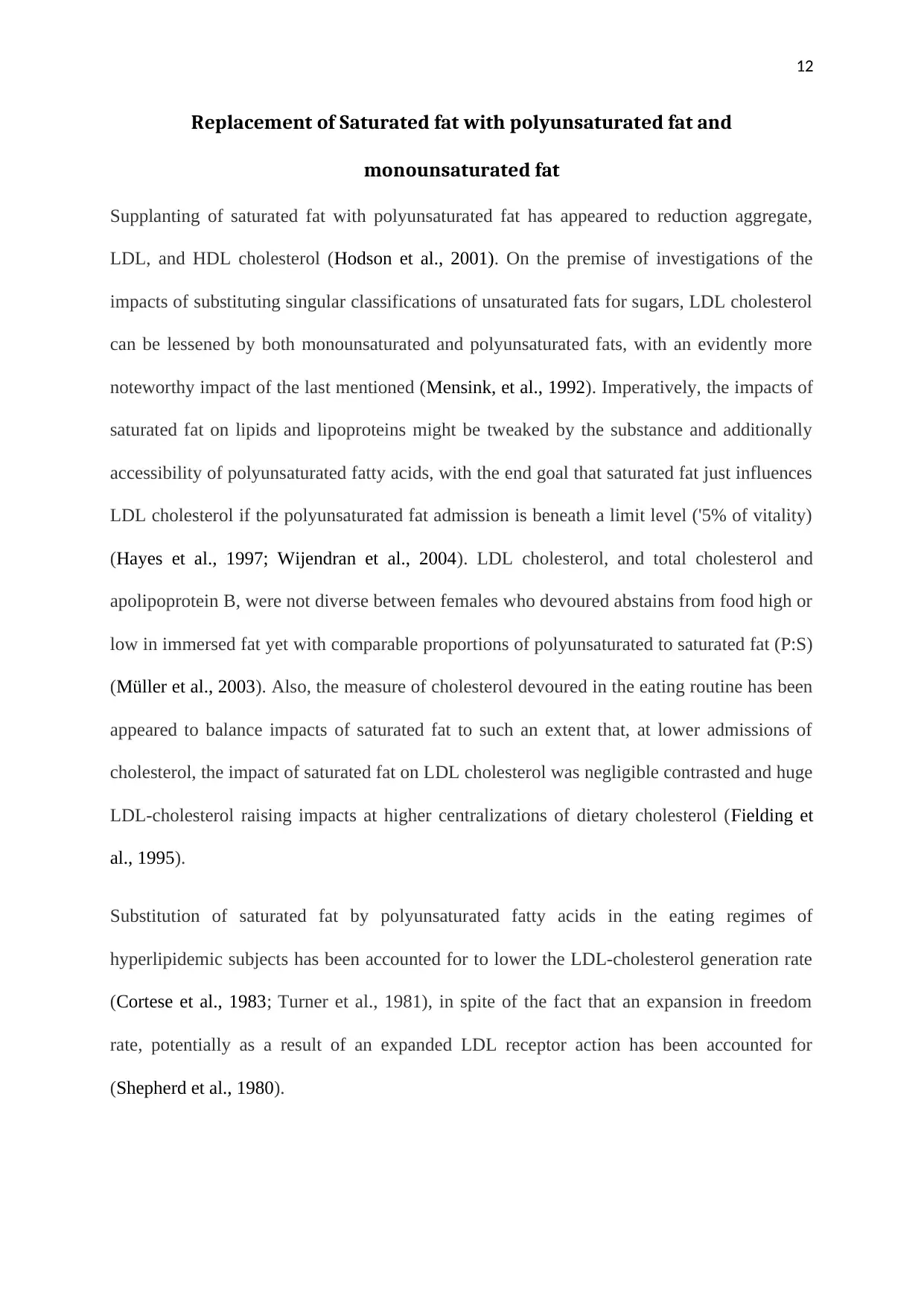
12
Replacement of Saturated fat with polyunsaturated fat and
monounsaturated fat
Supplanting of saturated fat with polyunsaturated fat has appeared to reduction aggregate,
LDL, and HDL cholesterol (Hodson et al., 2001). On the premise of investigations of the
impacts of substituting singular classifications of unsaturated fats for sugars, LDL cholesterol
can be lessened by both monounsaturated and polyunsaturated fats, with an evidently more
noteworthy impact of the last mentioned (Mensink, et al., 1992). Imperatively, the impacts of
saturated fat on lipids and lipoproteins might be tweaked by the substance and additionally
accessibility of polyunsaturated fatty acids, with the end goal that saturated fat just influences
LDL cholesterol if the polyunsaturated fat admission is beneath a limit level ('5% of vitality)
(Hayes et al., 1997; Wijendran et al., 2004). LDL cholesterol, and total cholesterol and
apolipoprotein B, were not diverse between females who devoured abstains from food high or
low in immersed fat yet with comparable proportions of polyunsaturated to saturated fat (P:S)
(Müller et al., 2003). Also, the measure of cholesterol devoured in the eating routine has been
appeared to balance impacts of saturated fat to such an extent that, at lower admissions of
cholesterol, the impact of saturated fat on LDL cholesterol was negligible contrasted and huge
LDL-cholesterol raising impacts at higher centralizations of dietary cholesterol (Fielding et
al., 1995).
Substitution of saturated fat by polyunsaturated fatty acids in the eating regimes of
hyperlipidemic subjects has been accounted for to lower the LDL-cholesterol generation rate
(Cortese et al., 1983; Turner et al., 1981), in spite of the fact that an expansion in freedom
rate, potentially as a result of an expanded LDL receptor action has been accounted for
(Shepherd et al., 1980).
Replacement of Saturated fat with polyunsaturated fat and
monounsaturated fat
Supplanting of saturated fat with polyunsaturated fat has appeared to reduction aggregate,
LDL, and HDL cholesterol (Hodson et al., 2001). On the premise of investigations of the
impacts of substituting singular classifications of unsaturated fats for sugars, LDL cholesterol
can be lessened by both monounsaturated and polyunsaturated fats, with an evidently more
noteworthy impact of the last mentioned (Mensink, et al., 1992). Imperatively, the impacts of
saturated fat on lipids and lipoproteins might be tweaked by the substance and additionally
accessibility of polyunsaturated fatty acids, with the end goal that saturated fat just influences
LDL cholesterol if the polyunsaturated fat admission is beneath a limit level ('5% of vitality)
(Hayes et al., 1997; Wijendran et al., 2004). LDL cholesterol, and total cholesterol and
apolipoprotein B, were not diverse between females who devoured abstains from food high or
low in immersed fat yet with comparable proportions of polyunsaturated to saturated fat (P:S)
(Müller et al., 2003). Also, the measure of cholesterol devoured in the eating routine has been
appeared to balance impacts of saturated fat to such an extent that, at lower admissions of
cholesterol, the impact of saturated fat on LDL cholesterol was negligible contrasted and huge
LDL-cholesterol raising impacts at higher centralizations of dietary cholesterol (Fielding et
al., 1995).
Substitution of saturated fat by polyunsaturated fatty acids in the eating regimes of
hyperlipidemic subjects has been accounted for to lower the LDL-cholesterol generation rate
(Cortese et al., 1983; Turner et al., 1981), in spite of the fact that an expansion in freedom
rate, potentially as a result of an expanded LDL receptor action has been accounted for
(Shepherd et al., 1980).
⊘ This is a preview!⊘
Do you want full access?
Subscribe today to unlock all pages.

Trusted by 1+ million students worldwide
1 out of 27
Your All-in-One AI-Powered Toolkit for Academic Success.
+13062052269
info@desklib.com
Available 24*7 on WhatsApp / Email
![[object Object]](/_next/static/media/star-bottom.7253800d.svg)
Unlock your academic potential
Copyright © 2020–2025 A2Z Services. All Rights Reserved. Developed and managed by ZUCOL.